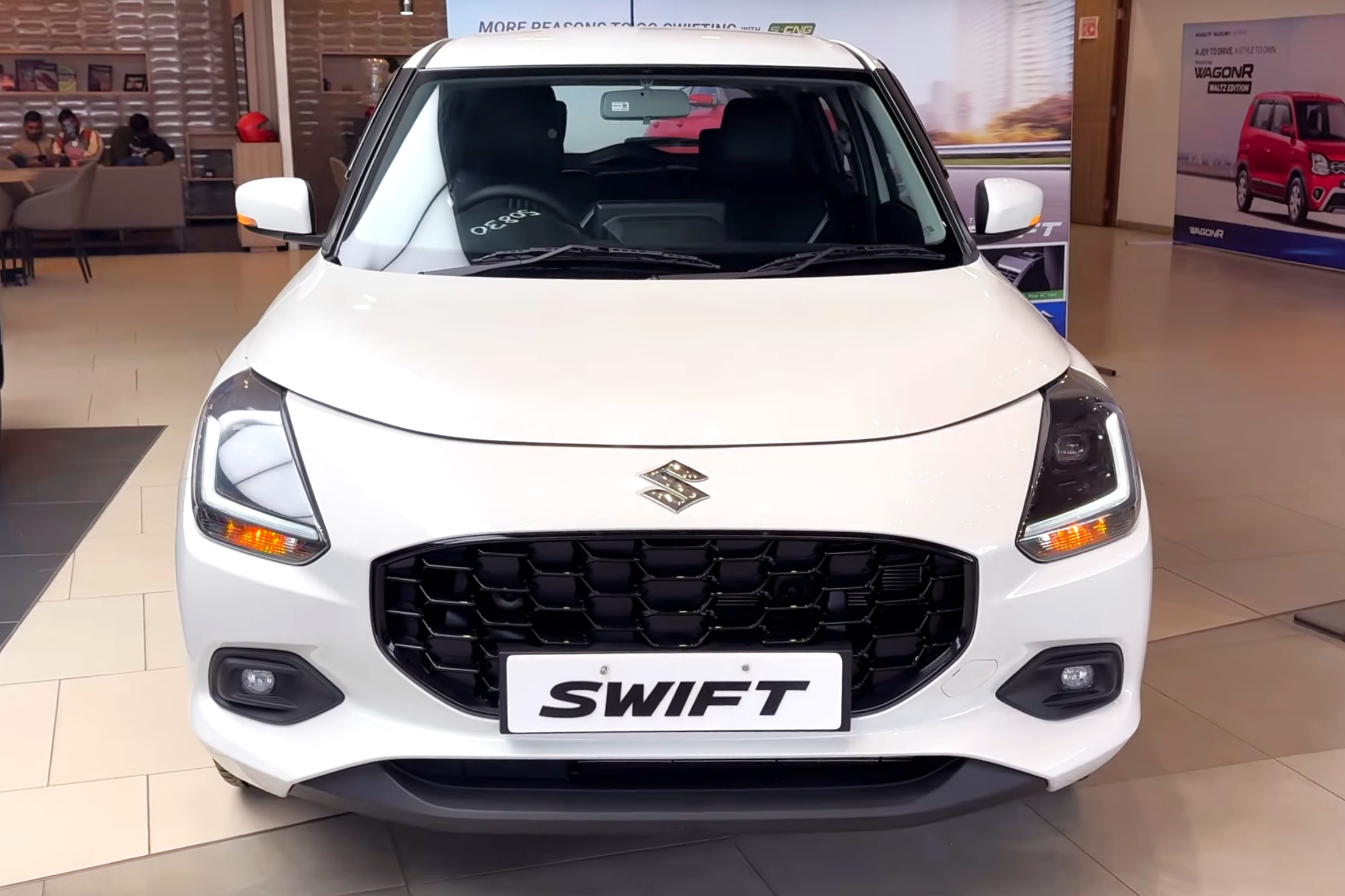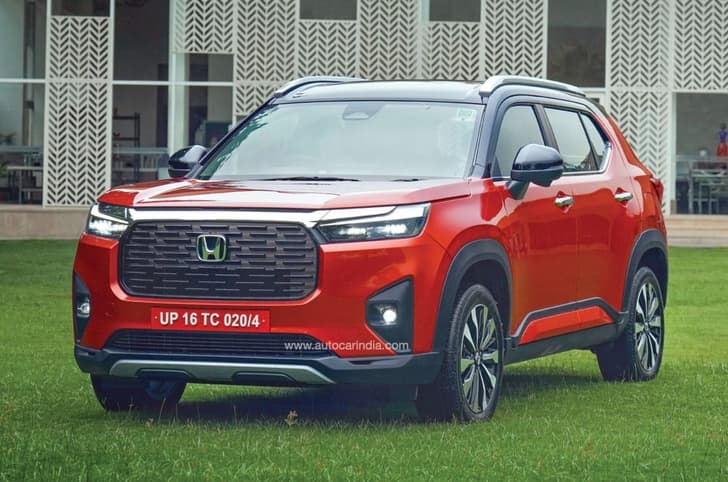FCA’s bid to gain a foothold in the Indian market with an aggressive pricing for the Jeep Compass (starting at Rs 14.95 lakh) means that the SUV's potential rivals now extend across segments. We have taken the Tata Hexa (156hp, 2.2-litre diesel), Mahindra XUV500 (140hp, 2.2-litre mHawk diesel), Hyundai’s Tucson (155hp, 2.0-litre petrol and 185hp, 2.0-litre diesel) and the Honda CR-V (156hp, 2.0-litre petrol 2WD MT and AT) to see if the Jeep can stand its ground on paper against this varied competition.
Design
The Compass is unmistakably a Jeep. The defined shoulder line, the sharp lines on the bonnet, those typical square, tough-looking wheel arches and the seven-slot grille make the SUV look like a small Grand Cherokee. There are, however, a few ungainly aspects such as the placement of the rear wheel in the wheel arch and the longish cabin but, otherwise, the Compass is a striking SUV. While it may be the smallest of the lot with the lowest capacity boot, it has a wheelbase that's longer than the CR-V's.
While Tata’s Impact design language is discernible in the Hexa’s grille, the overall styling, the glasshouse and silhouette are still quite MPV-like. It does get some rugged SUV-ish touches in the form of grey plastic cladding, a taller and more upright bonnet and squared-off edges. The rear features a thick band of chrome, faux diffuser and twin hexagonal tailpipes. A proper seven-seater, the Hexa is the largest and heaviest SUV here by a significant margin.
Mahindra gave the XUV500 a facelift in 2015. While the original silhouette was retained, the SUV looked fresher with a revised nose, a more contoured bonnet, a toothy new grille from the Scorpio, and upgraded headlights with new Z-shaped LED light guides. New 17-inch wheels, rear-view mirrors with integrated puddle lamps, chrome lining for the window line and a chrome garnish above the number plate are some of the highlights of the XUV500. The Mahindra, like the Hexa, offers a third row of seats but only gets a 93-litre boot space. With the last row folded, this goes up to 721 litres. Mahindra is expected to launch another facelift of the XUV500 in the coming months.
The Tucson wears Hyundai's Fluidic Sculpture 2.0 design language, much like the other offerings from the brand. An urban soft-roader, the Tucson’s front is dominated by the signature hexagonal grille flanked by swept-back headlights. A sharply rising window line is prominent on the side profile, while the rear is clean and simple with the tailgate sports slim LED lights.
The CR-V features a distinctive three-bar grille at the front, black cladding on the lower portion of the bumper and a skid-plate treatment below the bumper for an SUV-like look. The sharp lines, cuts and creases make the CR-V seem larger than it actually is. This five-seater is larger than its competition, barring the Hexa. The CR-V sold in international markets is a newer, seven-seater model. However, India still continues to get the previous-gen CR-V.
*With the third row of seats folded.
**With the second and third row of seats folded.
Interiors
Jeep has fitted the Compass’ cabin with soft-feel textures, supple leather and some chrome-finished bits. However, there are a few not-so-nice bits of hard and shiny plastic. While you do get the ‘luxury car’ vibe from the Compass, there is some essential kit missing in the form of cruise control, a sunroof, auto-dimming mirror and auto headlights and wipers. FCA hasn’t skimped on safety features though, and the Jeep gets ABS, ESP, Panic Brake Assist, Hydraulic Booster Failure Compensation, Electronic Roll Mitigation (essential in the US), Electronic Brake Pre-fill and six airbags.
The varied textures in the Hexa’s cabin and on the dash, the well-fitting panels and general quality of the switchgear are fairly good. There are also various storage spaces for knick-knacks. It gets a 10-speaker JBL sound system, ambient cabin lighting, faux leather upholstery, auto climate control, cruise control, a cooled glovebox, automatic headlamps and automatic wipers. The small 5.0-inch infotainment screen, however, is a bit of a let-down. Safety-wise, top-spec variants feature six airbags, ABS, EBD, ESP, traction control, hill descent control and hill hold.
The XUV500’s interiors are dual-tone beige and black and feature aluminium pedals, blue backlighting and a 7.0-inch touchscreen infotainment system (that doubles as a rear-view camera). The top-spec W10 variants also get features such as keyless entry and go, an electric sunroof and a six-way adjustable, powered driver’s seat. In terms of safety, all trim levels come with ABS with EBD and dual front airbags, though higher trims get six airbags, hill hold and descent control as well.
The Tucson, quite typically of Hyundai, is offered with a list of goodies and an adequate amount of safety features. While there is some resemblance to the smaller Creta, the cabin is spacious. It is equipped with an 8.0-inch touchscreen infotainment system that gets both Android Auto and Apple CarPlay. Leather is used on the steering, seats, armrests and transmission knob. The all-automatic cars have six airbags, with the manual variant getting just two. ABS with EBD are standard and the top trim gets electronic stability control, hill start and brake assist along with downhill brake control. Parking sensors are present for the front and rear, along with a rear-view camera.
Safety kit is par for the course in this segment with six airbags, ABS with EBD, vehicle stability assist, and hill start assist. In terms of equipment, the CR-V gets a touchscreen infotainment system that doubles a rear-view camera display with Bluetooth connectivity, dual-zone automatic air-con, an electric sunroof, cruise control and paddle shifters for the automatic gearbox.
Engines and performance
The Jeep Compass’ off-roading credentials are supported by the Selec-Terrain 4x4 system available on top-spec diesel variants. The 2.0-litre Multijet II engine puts out 173hp and 350Nm of peak torque, while the 1.4-litre MultiAir turbo-petrol mill is capable of putting out 162hp and 250Nm of torque. The power figures are good for the segment, but the torque figures are among the highest of the lot. While both engines come mated to a six-speed manual gearbox, the petrol gets an option of a seven-speed dual-clutch automatic as well. FCA claims 17.1kpl for the 4x2 diesel and 16.3kpl for the 4x4 diesel.
The Hexa’s 2.2-litre four-cylinder turbo-diesel motor in the XM to XT 4x4 trims, produces 156hp and 400Nm of torque and is shared with the Safari Storme Varicor 400. The engine is paired to a six-speed manual though a six-speed automatic is also on offer. Only the manual variants get an optional 4x4 system.
The XUV500 is down on power when compared to its rivals but it has a torquey diesel engine. The 2.2-litre mHawk diesel engine makes 140hp and 330Nm of torque. Mahindra claims a fuel efficiency figure of 16kpl for the XUV500. The facelift that is due to arrive soon will also have a more powerful 170hp, 2.2-litre engine and that will make it better equipped to take on rivals.
The Tucson gets a choice of petrol and diesel engines. The 2.0-litre petrol produces 155hp and 192Nm of torque, while the 2.0-litre diesel churns out 185hp and 400Nm of peak twisting force. Both engines are paired to six-speed manual and six-speed automatic transmissions. The ARAI-certified fuel efficiency for the petrol is 13.03kpl (12.95kpl for the automatic) and 18.42kpl (16.38kpl for the automatic) for the diesel engine.
The 2.0-litre Honda CR-V develops 156hp and 190Nm of peak torque. It is mated to a six-speed manual or an optional five-speed automatic that sends power to the front wheels only. It is the thirstiest of the lot with an ARAI-certified mileage of 13.7kpl for the automatic 2.0-litre engine.
Pricing
Jeep offers the Compass with ten variants including both engines options. The entry-level petrol variant is priced starting at Rs 14.95 lakh and the entry-level diesel variant at Rs 15.45 lakh (ex-showroom, Delhi). The top-spec petrol with the automatic gearbox is priced at Rs 19.40 lakh, but misses out on the 4x4 system, while the fully loaded diesel variant costs Rs 20.65 lakh.
Thanks to this really aggressive pricing, the Compass can match the lower-priced Tata Hexa XM that starts at Rs 12.81 lakh and Mahindra XUV500 that starts at Rs 12.03 lakh and goes up to Rs 18.17 lakh. The more upmarket Tucson costs between Rs 18.13 and Rs 23.86 lakh, and the CR-V is priced between Rs 21.54 and Rs 23.26 lakh.
While it is true that the Jeep loses out in terms of some kit, especially compared to the Tata that offers great value for money, the pricing and on-paper performance means the American brand could head in a new direction. A full road test will be necessary to find out which SUV takes home the victory, but for now, the Compass makes a compelling argument for itself.







































